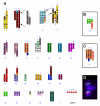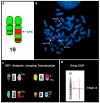Definitive molecular cytogenetic characterization of 15 colorectal cancer cell lines
- PMID: 19927377
- PMCID: PMC2818350
- DOI: 10.1002/gcc.20730
Definitive molecular cytogenetic characterization of 15 colorectal cancer cell lines
Abstract
In defining the genetic profiles in cancer, cytogenetically aberrant cell lines derived from primary tumors are important tools for the study of carcinogenesis. Here, we present the results of a comprehensive investigation of 15 established colorectal cancer cell lines using spectral karyotyping (SKY), fluorescence in situ hybridization, and comparative genomic hybridization (CGH). Detailed karyotypic analysis by SKY on five of the lines (P53HCT116, T84, NCI-H508, NCI-H716, and SK-CO-1) is described here for the first time. The five lines with karyotypes in the diploid range and that are characterized by defects in DNA mismatch repair had a mean of 4.8 chromosomal abnormalities per line, whereas the 10 aneuploid lines exhibited complex karyotypes and a mean of 30 chromosomal abnormalities. Of the 150 clonal translocations, only eight were balanced and none were recurrent among the lines. We also reviewed the karyotypes of 345 cases of adenocarcinoma of the large intestine listed in the Mitelman Database of Chromosome Aberrations in Cancer. The types of abnormalities observed in the cell lines reflected those seen in primary tumors: there were no recurrent translocations in either tumors or cell lines; isochromosomes were the most common recurrent abnormalities; and breakpoints occurred most frequently at the centromeric/pericentromeric and telomere regions. Of the genomic imbalances detected by array CGH, 87% correlated with chromosome aberrations observed in the SKY studies. The fact that chromosome abnormalities predominantly result in copy number changes rather than specific chromosome or gene fusions suggests that this may be the major mechanism leading to carcinogenesis in colorectal cancer.
Figures




References
-
- Bunz F, Dutriaux A, Lengauer C, Waldman T, Zhou S, Brown JP, Sedivy JM, Kinzler KW, Vogelstein B. Requirement for p53 and p21 to sustain G2 arrest after DNA damage. Science. 1998;282:1497–1501. - PubMed
-
- Camps J, Morales C, Prat E, Ribas M, Capellà G, Egozcue J, Peinado MA, Miró R. Genetic evolution in colon cancer KM12 cells and metastatic derivates. Int J Cancer. 2004a;110:869–874. - PubMed
Publication types
MeSH terms
Grants and funding
LinkOut - more resources
Full Text Sources
Medical
Research Materials

